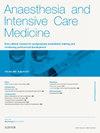Neurological complications in obstetric regional anaesthesia
IF 0.3
Q4 ANESTHESIOLOGY
引用次数: 0
Abstract
Central neuraxial blocks represent the most executed procedures in the field of obstetric anaesthesia. Most neurological complications observed in the post-partum period arise from obstetric palsies associated with the natural process of labour. It is crucial for anaesthetists to adopt a systematic methodology when evaluating neurological injuries to differentiate between causes related to anaesthesia and those that are not. Additionally, it is vital to promptly recognize circumstances that necessitate urgent investigation and intervention to avert lasting damage. Anaesthetists should possess a thorough understanding of the principles of safe practice while conducting a neuraxial block. This encompasses implementing recommended precautions to reduce the likelihood of neurological complications, such as assessing coagulation status, following infection control protocols, ensuring proper positioning and technique, maintaining effective communication with the patient throughout the procedure, and monitoring the resolution of the neuraxial block using regional anaesthesia bracelets. Moreover, anaesthetists must engage in a multidisciplinary approach to minimize risks by consulting with obstetricians, haematologists, and neurologists, as well as ensuring appropriate follow-up care and management for patients who are affected.
产科区域麻醉中的神经系统并发症
中枢神经轴阻滞是产科麻醉领域执行最多的手术。产后观察到的大多数神经系统并发症是由与自然分娩过程有关的产科麻痹引起的。对于麻醉师来说,在评估神经损伤时采用系统的方法来区分与麻醉相关的原因和非麻醉原因是至关重要的。此外,至关重要的是迅速认识到需要紧急调查和干预的情况,以避免持久的损害。麻醉师在进行神经轴阻滞时应该对安全操作的原则有透彻的了解。这包括实施推荐的预防措施以减少神经系统并发症的可能性,例如评估凝血状态,遵循感染控制方案,确保正确的定位和技术,在整个手术过程中与患者保持有效的沟通,并使用区域麻醉手环监测神经轴阻滞的解决。此外,麻醉师必须通过咨询产科医生、血液科医生和神经科医生,以及确保对受影响的患者进行适当的后续护理和管理,参与多学科方法,以尽量减少风险。
本文章由计算机程序翻译,如有差异,请以英文原文为准。
求助全文
约1分钟内获得全文
求助全文
来源期刊

Anaesthesia and Intensive Care Medicine
ANESTHESIOLOGY-
CiteScore
0.50
自引率
0.00%
发文量
152
期刊介绍:
Anaesthesia and Intensive Care Medicine, an invaluable source of up-to-date information, with the curriculum of both the Primary and Final FRCA examinations covered over a three-year cycle. Published monthly this ever-updating text book will be an invaluable source for both trainee and experienced anaesthetists. The enthusiastic editorial board, under the guidance of two eminent and experienced series editors, ensures Anaesthesia and Intensive Care Medicine covers all the key topics in a comprehensive and authoritative manner. Articles now include learning objectives and eash issue features MCQs, facilitating self-directed learning and enabling readers at all levels to test their knowledge. Each issue is divided between basic scientific and clinical sections. The basic science articles include anatomy, physiology, pharmacology, physics and clinical measurement, while the clinical sections cover anaesthetic agents and techniques, assessment and perioperative management. Further sections cover audit, trials, statistics, ethical and legal medicine, and the management of acute and chronic pain.
 求助内容:
求助内容: 应助结果提醒方式:
应助结果提醒方式:


